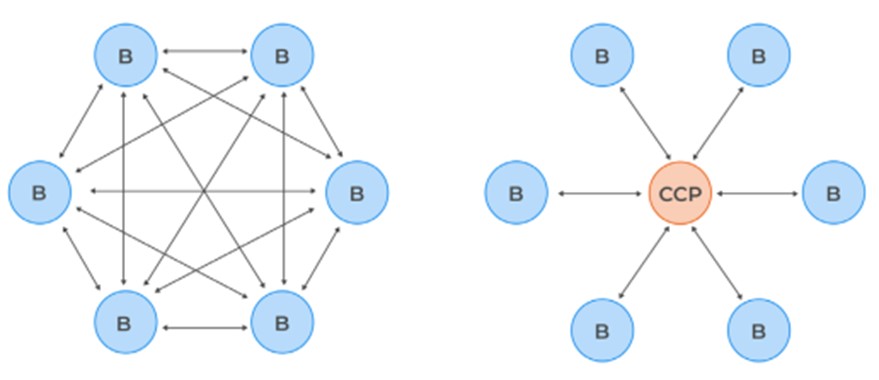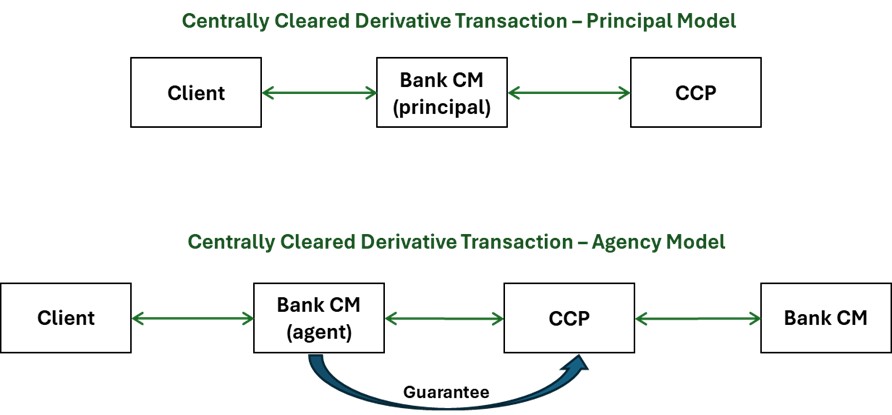How the US GSIB Surcharge and Basel III Endgame Proposals Impair Client Clearing of OTC Derivatives
- Lindsey Keljo
- Dr. Guowei Zhang, Kyle Brandon, and Lindsey Keljo
- The Federal Reserve should exclude client clearing of OTC derivatives from the GSIB surcharge’s complexity and interconnectedness indicators and from the Basel III Endgame’s CVA capital requirements.
- Client clearing of OTC derivatives reduces the complexity and interconnectedness of clearing member banks. And, under the agency model, a clearing member bank’s guarantee of clients’ performance to CCPs is no more complex than simple credit exposure.
- In addition, the clearing member bank is not exposed to CVA risk arising from its client-cleared OTC derivatives.
1. Central clearing of OTC derivatives reduces complexity and interconnectedness of OTC derivatives market participants
In response to the 2007-2009 global financial crisis (“GFC”), the G20, in its 2009 Pittsburgh Accord, highlighted the need to prioritize central clearing of standardized over-the-counter (“OTC”) derivatives to “improve transparency in the derivatives markets, mitigate systemic risk”.[1] Central clearing of OTC derivatives offers several well-recognized benefits that include reduced complexity and interconnectedness of market participants through multilateral netting and the reduction of bilateral counterparty relationships (see Figure 1), enhanced market transparency as central counterparties (“CCPs”) provide greater transparency into pricing and risk exposures and facilitation of porting to reduce systemic risk.
In recognition of these benefits, regulators globally have established central clearing as a core capital markets’ regulatory reform, incentivizing banks to centrally clear OTC derivatives via a clearing mandate,[2] preferential capital requirements [3] and margin requirements.[4] Consequently, the percentage of centrally cleared OTC derivatives has grown significantly since the GFC. As of June 2023, 70-80% (in terms of notional amount) of interest rate derivatives and credit derivatives are centrally cleared.[5]
Figure 1. Depiction of central clearing reduces complexity and interconnectedness of market participants.[6]

2. Robust client clearing of OTC derivatives is a key pillar of financial stability
CFTC data shows in the past decade the number of futures commission merchants, i.e., clearing members, decreased from 22 to 12, and all 12 are GSIBs.[7] The decrease is largely due to the low margin of client clearing service coupled with high regulatory requirements (e.g., the supplementary leverage ratio requirements or “SLR”). The top 6 are U.S. GSIBs that collectively represent 85% of total client-cleared swaps as measured by the initial margin required. Most clients are not equipped with resources to become clearing members of CCPs and rely on clearing members to clear their OTC derivatives. They include a wide range of OTC derivatives users including agriculture and food producers, energy companies, insurance companies, and pension funds that use derivatives to hedge their day-to-day commercial and operating risks. Consequently, robust client clearing of OTC derivatives is a key pillar of the smooth functioning of the derivatives market and financial stability.
Globally, client clearing of OTC derivatives uses two structures – the agency model and the principal model (see Figure A1 in the Appendix for a depiction of the two models).[8] Client clearing, in both the agency and principal model, reduces the complexity and interconnectedness in the resolution of a GSIB, compared to GSIBs engaged in bilateral OTC derivatives trading. In the U.S., the agency model is the predominant structure for OTC derivatives that are centrally cleared. For instance, over 80% of the notional amount of LCH SwapClear’s client-cleared OTC derivatives use the agency model.[9]
3. Capital requirements for client-cleared OTC derivatives will change under the proposed GSIB surcharge and Basel III Endgame
Capital requirements for client-cleared OTC derivatives under the current U.S. capital rules
Under the current capital rules, U.S. GSIBs are subject to a suite of capital requirements including the minimum risk-based and leverage capital requirements, and additional capital buffer requirements, e.g., the stress capital buffer (“SCB”) and the GSIB surcharge. Many of these requirements go above and beyond the Basel international standards as explained previously in our blog, Understanding the Current Regulatory Capital Requirements Applicable to US Banks.
Regarding risk-based capital requirements, U.S. GSIBs are required to do two sets of calculations – the U.S. standardized approach and the Advanced Approaches[10] – and use the higher of the two as the binding capital requirement. Given the SCB is applied to the U.S. standardized approach but not the Advanced Approaches, at any given time either approach could become the binding risk-based capital constraint depending on a GSIB’s risk profile. Currently, all the 8 U.S. GSIBs are bound by the U.S. standardized approach. Thus, client-cleared OTC derivatives are currently capitalized by the standardized approach for counterparty credit risk and the SCB.[11] In addition, these derivatives are captured by the SLR, which created binding capital requirements for many years for all GSIBs and is now once again binding for some GSIBs – meaning the leverage capital requirements exceed the risk-based capital requirements.
Separately, client-cleared OTC derivatives are capitalized by the current U.S. GSIB surcharge via its size indicator. And, consistent with the Basel GSIB score methodology,[12] the U.S. GSIB surcharge’s complexity and interconnectedness indicators currently exclude client-cleared OTC derivatives cleared through the agency model. These indicators are the starting point for GSIB score calculation under Method 1 (consistent with the Basel methodology) and Method 2 (a unique U.S. approach).[13] As we discussed in a separate blog, The Federal Reserve Should Revise the US GSIB Surcharge Methodology to Reflect Real Risks and Support the Economy, Method 2 generally produces a higher score than Method 1 and leads to a higher surcharge for U.S. GSIBs.
Capital requirements for client-cleared OTC derivatives under the proposed GSIB surcharge and Basel III Endgame
The Federal Reserve proposed material changes to the treatment of client-cleared OTC derivatives under the capital rules. In particular, these derivatives would be included in the GSIB surcharge’s complexity and interconnectedness indicators going above and beyond the Basel international standards. Additionally, the Basel III Endgame proposal would apply the SCB to the expanded risk-based approach (“ERBA”). The ERBA would also become the binding risk-based capital requirements for U.S. GSIBs. Under the ERBA, client-cleared OTC derivatives would be capitalized by the CVA risk framework and the operational risk framework in addition to the current counterparty credit risk framework and the SCB. Whereas in other major jurisdictions, e.g., the European Union, client-cleared OTC derivatives are exempt from CVA capital requirements.[14]
These proposed changes are expected to substantially increase capital requirements for client-cleared OTC derivatives and risk undoing the regulatory capital incentives to centrally clear OTC derivatives. According to SIFMA/ISDA’s quantitative impacts study,[15] these two proposals collectively would raise capital requirements for U.S. GSIBs’ client-cleared OTC derivatives by over 80% (from the current $9bn to $16.2bn). The GSIB surcharge proposal accounts for 58% (or $5.2bn) of the increase and the Basel III Endgame proposal is responsible for the remaining 22% ($2.0bn). As we explained in another blog, Why the Federal Reserve Should Pay Particular Attention to Banks’ Capital Markets Activities When Deliberating Revisions to the Basel III Endgame Proposal, banks allocate equity capital to the business segment and viable businesses need to meet return on equity (“ROE”) targets. Assuming a ROE target of 15%, to cover the $7.2bn increase in equity capital the additional return required from client clearing businesses would have to be about $1.1bn on a go-forward basis.
The additional required return would put pressure on the GSIBs’ capacity to support client clearing services and increase costs to derivatives end-users. Additionally, capital-constrained clearing member banks are less likely to accept the port of a book of business from a defaulting clearing member. Unsuccessful porting would lead to market liquidations of such a book which will likely create even greater strain on markets, especially in a time of stress.
4. The Federal Reserve should exempt client-cleared OTC derivatives from the proposed GSIB surcharge and Basel III Endgame
As explained in Section 1, client clearing of OTC derivatives reduces complexity and interconnectedness of market participants including banks as clearing members. Under the agency model, clearing member banks only guarantee the performance of their clients to CCPs and the guarantee is no “more complex than a simple credit exposure.” As a result, in 2018, the Federal Reserve believed it is not “necessary to include these exposures in the complexity indicator.”[16] To stay consistent with the Basel international standards and avoid unduly penalizing U.S. GSIBs’ client clearing services, the Federal Reserve should exclude client-cleared OTC derivatives under the agency model from the GSIB surcharge’s complexity and interconnectedness indicators.
Additionally, under the agency model clearing member banks are not exposed to CVA risk arising from client-cleared OTC derivatives.[17] To ensure capital requirements are commensurate with risks, the Federal Reserve should exempt client-cleared OTC derivatives from the Basel III Endgame’s CVA capital requirements.
5. Conclusion
For the reasons laid out above, client-cleared OTC derivatives should be excluded from the GSIB score’s complexity and interconnectedness indicators and exempted from the Basel III Endgame’s CVA capital requirements. These amendments would help ensure capital requirements for client-cleared OTC derivatives are commensurate with the risks that they create and would be consistent with supporting the central clearing of OTC derivatives as a core element of systemic risk regulation. Additionally, these amendments would ensure end-users continue having access to clearing services on their OTC derivatives transactions at reasonable costs.
Appendix
Figure A1. Depiction of central clearing agency vs principal model.

Authors
Dr. Guowei Zhang is Managing Director and Head of Capital Policy.
Ms. Kyle Brandon is Managing Director and Head of Derivatives Policy.
Ms. Lindsey Keljo is Managing Director, Head of Asset Management Group and Associate General Counsel.
Footnotes
[1] See http://www.g20.utoronto.ca/2009/2009communique0925.html
[2] Regulators around the world have implemented clearing mandates for certain standardized OTC derivatives contracts. These mandates require market participants to clear eligible derivatives transactions through CCPs.
[3] Regulatory capital rules typically impose higher capital requirements on intermediaries of non-centrally cleared derivatives transactions compared to centrally cleared ones. This encourages market participants to centrally clear their OTC derivatives trades to be more capital efficient.
[4] Regulatory margin requirements for non-centrally cleared derivatives are often more stringent compared to centrally cleared transactions, incentivizing market participants to clear through CCPs, when possible.
[5] See https://stats.bis.org/statx/srs/table/d5.1
[6] See https://www.fia.org/sites/default/files/2024-01/FIA%20-%202023%20G-SIB%20Surcharge%20Comment%20Letter.pdf
[7] See https://www.cftc.gov/MarketReports/financialfcmdata/index.htm
[8] Under the agency model, the clearing member (“CM”) acts as agent for its client (which enters the derivative with a CCP) and guarantees the client’s performance to the CCP. While under the principal model, the CM and its client face each other as principal, and the CM enters an equal and offsetting transaction with the CCP.
[9] See https://www.fdic.gov/resources/regulations/federal-register-publications/2023/2023-regulatory-capital-rule-large-banking-organizations-3064-af29-c-176.pdf
[10] Under the current capital rules, banks may use internal models to calculate capital requirements for credit risk, market risk, CVA risk, and operational risk. These internal models are collectively referred to as the Advanced Approaches.
[11] CVA losses arising from client-cleared OTC derivatives are included in the SCB’s global market shock loss estimates, while the counterparty default losses associated with these derivatives, as applicable, are captured by its largest counterparty default component.
[12] See https://www.bis.org/bcbs/gsib/instr_end23_gsib.pdf
[13] See https://www.ecfr.gov/current/title-12/chapter-II/subchapter-A/part-217/subpart-H
[14] See CRR3 Article 382
[15] See https://www.sifma.org/resources/news/sifma-responds-to-u-s-basel-iii-and-g-sib-surcharge-consultations/
[16] See https://www.govinfo.gov/content/pkg/FR-2018-07-03/pdf/2018-14304.pdf
[17] Banks are, however, subject to contingent market risk of the collaterals posted by a defaulting client. But such market risk is captured by the applicable supervisory haircut.
Details
More Content
- Pennsylvania + WallDec 18, 2025
Bank of America’s Hari Gopalkrishnan on AI, Innovation, and the Customer Experience
Hari Gopalkrishnan discusses the future of AI, the evolution of customer and employee experiences, and the strategic decisions driving Bank of America’s $13 billion annual technology investment.
Details
More Content
- Pennsylvania + WallDec 18, 2025
Bank of America’s Hari Gopalkrishnan on AI, Innovation, and the Customer Experience
Hari Gopalkrishnan discusses the future of AI, the evolution of customer and employee experiences, and the strategic decisions driving Bank of America’s $13 billion annual technology investment.